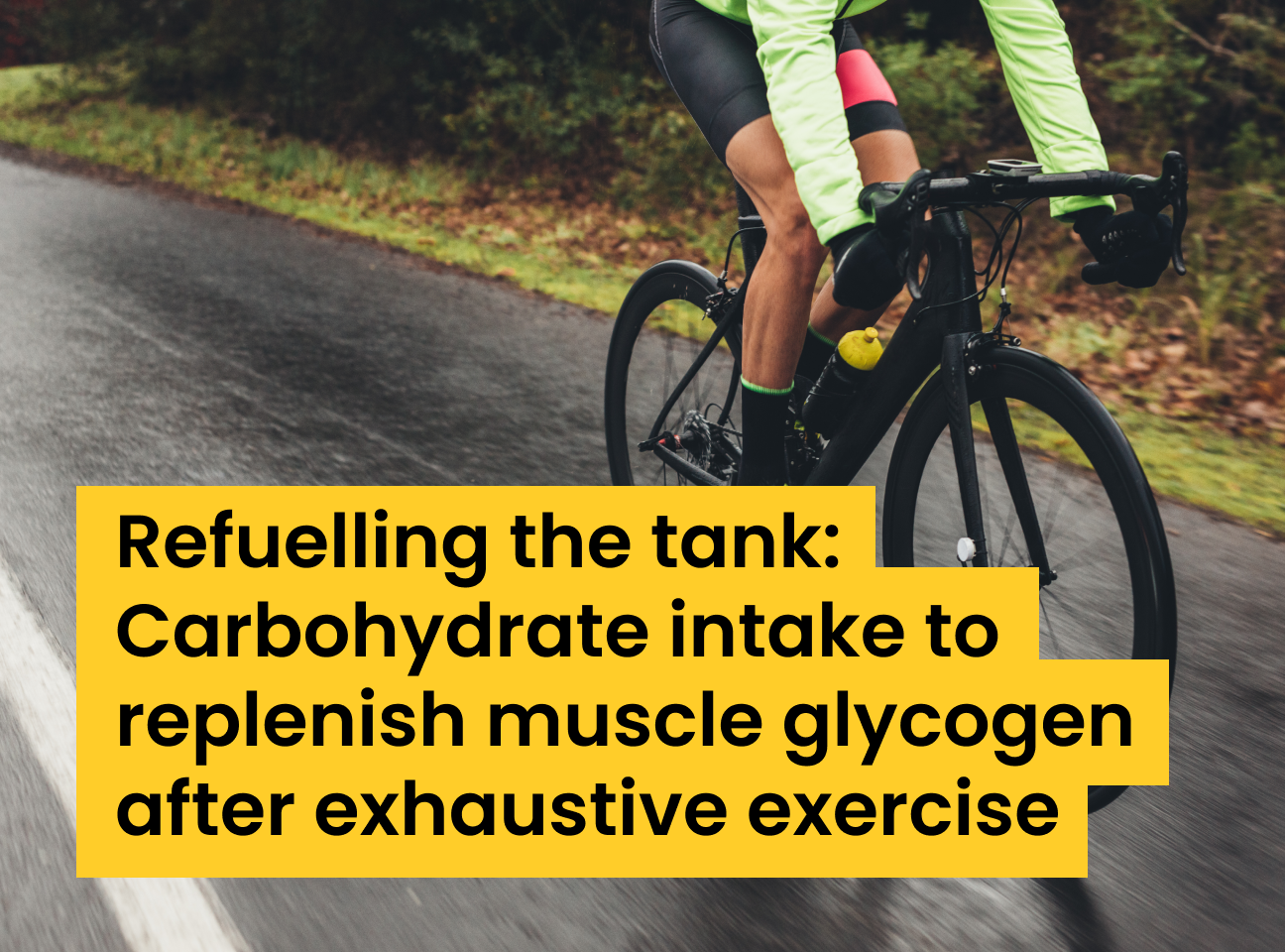
Refuelling the tank: Carbohydrate intake to replenish muscle glycogen after exhaustive exercise
By Dr. Mark Hearris

Research: Effect of different carbohydrate intakes within 24 hours after glycogen depletion on muscle glycogen recovery in Japanese endurance athletes by Motonaga et al (2022)
Introduction:
Given the hectic schedule of many athletes and limited time-frame between training sessions or competitive events, the repletion of muscle glycogen after exercise is a critical aspect of recovery to repeatedly promote high-levels of performance. Just like a car with a small petrol tank, the muscle has a limited capacity to store glycogen which means carbohydrate intake following exercise must be carefully considered to ensure glycogen availability does not become limiting to performance. However, unlike filling a tank of petrol which takes just a matter of minutes, the repletion of muscle glycogen is known to take multiple hours through to several days depending on the level of depletion and amount of carbohydrate in the diet. For practitioners, data that provides an insight into the quantities of carbohydrate required to facilitate glycogen repletion and the time course in which this occurs is invaluable and allows them to provide better recommendations to their athletes.
The study:
Using a repeated measures design, eight college athletes (age, 20 ± 1 years; VO₂max, 55.8 ± 6.0 ml/kg BM) undertook three different experiment trials in a randomised order. On each visit, subjects completed an exhaustive exercise protocol to deplete muscle glycogen, consisting of 60 minutes of cycling at 70% VO₂max, 5 x 1 min intervals as 100% VO₂max and a final bout of continuous cycling at 100% VO₂max until fatigue and received three different diets which varied in total carbohydrate intake, equating to either 5, 7 or 10 g/kg BM. Diets were also matched for total energy (3,200 kCal) and protein (2.0 g/kg BM) but contained different amounts of fat (in order to ensure they remained energy matched), which equated to absolute fat intakes of 174, 125 and 58 g fat, respectively. Diets consisted of three main meals of lunch (consumed 1 h post-exercise), dinner (consumed 7 h post-exercise) and breakfast the subsequent morning (consumed 19 h post-exercise). Muscle glycogen was measured prior to the depleting exercise (baseline), immediately post-exercise and 4, 12 and 24 h post-exercise using non-invasive magnetic resonance spectroscopy (MRS) as opposed to the traditional muscle biopsy approach.
A closer look: Non-invasive measurement of glycogen using MRS
When lying inside an MR scanner, many people commonly undergo magnetic resonance imaging (MRI) which provides detailed images of the structure of our anatomy. However, these scanners can also be specially programmed to measure the chemical composition of various tissues, including the presence of glycogen within skeletal muscle. Whilst the physics behind this technique is highly complex, the presence of glycogen within the tissue emits a small signal which can be picked up by the scanner and used to measure changes in response to both exercise and carbohydrate feeding. The bigger the signal received; the more glycogen stored within the tissue. This advancement allows for glycogen to be measured non-invasively as opposed to taking repeated biopsy samples which could indirectly alter glycogen resynthesis due to the tissue damaged being caused by repeated sampling. Using this study as an example, 15 biopsy samples per participant would have been required to measure glycogen at all five time-points across multiple trials as opposed to approximately 30 minutes of scanning.
Findings:
The glycogen data demonstrate that the exercise protocol was successful in depleting muscle glycogen post-exercise where concentrations were reduced by approximately 70% in all trials. Over the course of the next 4 hours (which included lunch), glycogen increased to around 50% of pre-exercise values, with the rate of increase being similar across all conditions, despite differences in carbohydrate intake at lunch. However, when glycogen was measured again 8 hours later (12 h post-exercise) concentrations had increased to approximately 80% of pre-exercise values in the 7 and 10 g/kg CHO trials and were significantly higher when compared with the 5 g/kg CHO trial which remained at around 60% of pre-exercise values. When measured after 24 hours, glycogen values were completely restored to pre-exercise values in the 7 and 10 g/kg CHO trials but only reached 80% of pre-exercise values when subjects were fed 5 g/kg CHO. When looking at the data in finer detail, it is also clear that there is large variability in rates of resynthesis between participants, which is likely explained by the amount of glycogen depleted by the exercise as this can significantly impact rates of recovery. For example, in some participants, it appears that glycogen may have been fully restored with feeding 5 g/kg CHO whilst, in others, glycogen was only recovered by 50% of pre-exercise values.
Relevance:
The data from the study demonstrate that a carbohydrate intake of 7 g/kg BM is sufficient to fully restore muscle glycogen to pre-exercise levels within 24 hours, with lower intakes resulting in only partial (approximately 80%) repletion. Whilst the lower carbohydrate intake failed to fully replete muscle glycogen to pre-exercise levels, I would challenge practitioners to ask themselves whether full repletion is always required to promote high-level performance. Whilst the answer to this question is likely to be yes in circumstances where glycogen availability is limiting to performance or when athletes consistently fail to replenish muscle glycogen, there will undoubtedly be situations in where partial glycogen repletion will be sufficient. This sentiment reminds me of a classic study from the early 1980s by William Sherman and colleagues who demonstrated that higher pre-exercise carbohydrate intakes led to greater glycogen storage but provided no additional benefit to half marathon performance (Sherman et al., 1981). Interestingly, the message conveyed by these authors in their discussion of their findings still appear to ring true to this day:
“The performance times indicate that carbohydrate loading was of no benefit to performance during the 20.9 km run. In fact, performance times were actually slower in the trials with higher levels of muscle glycogen. This suggests that anything above a minimal level of muscle glycogen is unnecessary for performance of a given intensity and duration. More importantly, the practical question may not be how much can I super-compensate but rather, does my diet contain enough carbohydrate to maintain adequate stores of muscle glycogen on a day-to-day basis for training and performance runs?” (p. 117).
Complement this research with the We Do Science podcast episode: Carbohydrates with Prof James Morton
References:
Sherman, W. M., Costill, D. L., Fink, W. J., & Miller, J. M. (1981). Effect of exercise-diet manipulation on muscle glycogen and its subsequent utilization during performance. Int J Sports Med, 2(2), 114-118. https://doi.org/10.1055/s-2008-1034594
